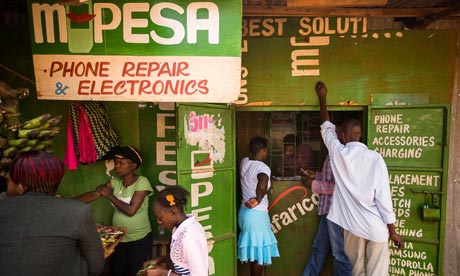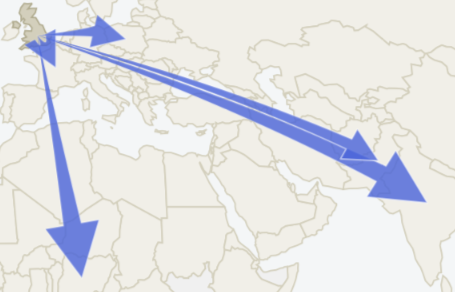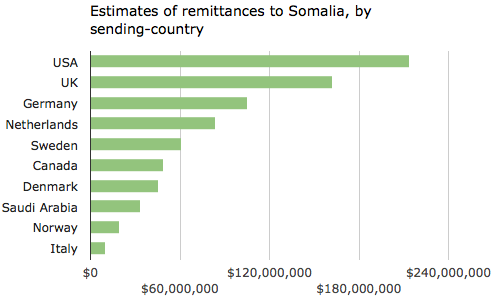Remittances: how much Britain sends, and where the cash goes – get the data
British MPs have criticised Barclays for its decision to pull out of the money-transfer industry. But how much do migrants living in the UK send 'home'? And where does the money go?

On the money … a Nairobi shop offering M-Pesa. Barclays has been panned for closing UK accounts that enable cash transfers. Photograph: Trevor Snapp/Getty
British MPs, academics, an Olympic gold medallist, and the central bank governor of Somalia are among those protesting against the decision byBarclays to close the accounts of hundreds of money-transfer companies. Critics say the move will have a devastating impact on some of the world's poorest communities.
Remittances, money sent by migrants to friends and family back home, are worth billions of dollars globally. For dozens of developing countries, these flows far exceed the amount they receive in aid.
However, companies that handle this money have been repeatedly challenged since September 11, which brought heightened suspicion and increased regulation of the industry. The UK Money Transmitters Association (UKMTA) says Barclays' decision – which follows a similar move by HSBC this year – will impact almost 70% of UK money-transfer firms.
But how much are remittances worth? How much do migrants living in the UK send home? And where does the money go?
Remittances from the UK
Globally, official records suggest migrants have sent more than $500bn (£320bn) in remittances. In 2011, recorded remittances from the UK were worth just over $3.2bn.
Government statistics rarely include details on where remittances end up, however. It is difficult to understand how much money being sent from Switzerland, for example, comes directly from migrant workers there and how much is being routed through Swiss banks. World Bank economists say the true size of remittance flows could be much larger than official records suggest as many people continue to bypass banks and big money-transfer companies.
This year we built an interactive using the World Bank's estimates on the true size and direction of global remittance flows. The blue arrows show the top five recipients of remittances from the UK.
 Explore the World Bank's bilateral remittances estimates in our interactive
Explore the World Bank's bilateral remittances estimates in our interactive
According to the estimates, remittances from the UK, including unrecorded transfers through formal and informal channels, could be worth up to $23bn – including $3.9bn to India, $3.8bn to Nigeria, and more than $1.2bn to Poland. This would make the UK the third-largest source of remittances, after the US and Canada.
The World Bank's estimates of bilateral remittances are based on data for the number of migrants living in different countries and economic statistics for both sending and receiving countries. Its figures are not perfect, however. For example, there is no data on estimated remittances from the UK to Somalia.
Remittances to Somalia
Critics of Barclays' decision to pull out of the money-transfer industry say it will be particularly damaging for people who send money to Somalia, which has no formal banking system and relies on remittances for a significant portion of its national income.
 Source: Oxfam 2013, all figures in US$
Source: Oxfam 2013, all figures in US$
Remittances to Somalia are estimated at between $1bn and $2bn a year, with a significant portion probably contributed by UK-based migrants.Oxfam estimates that Somalis living in the UK send more than $162m to Somalia each year.
A survey of 718 households in Somaliland and Puntland, meanwhile, found one in four respondents received support from a single relative in the UK. The bulk of money sent was used by families to cover basic household expenses such as food, clothing, education and healthcare.
Only a fraction of money-transfer businesses that remit to Somalia have accounts with Barclays. It is unclear, however, how much money they handle and what percentage of remittances to Somalia will be affected by the bank's withdrawal from the sector.
The cost of sending money home
The debate provoked by Barclays' decision has thrown the spotlight on the industry behind the multibillion-dollar flow of migrants' money worldwide.
One of the biggest complaints from migrants has long been the cut taken by banks and money transfer firms. The table below shows the average cost of sending money from the UK to 15 selected countries, according to data published by the World Bank.
The World Bank's data on the cost of sending and receiving remittancescovers 220 "corridors", including 32 major remittance-sending countries and 89 receiving countries. It does not include every possible combination of countries, but the corridors it covers represent more than 60% of total remittances to developing countries.

